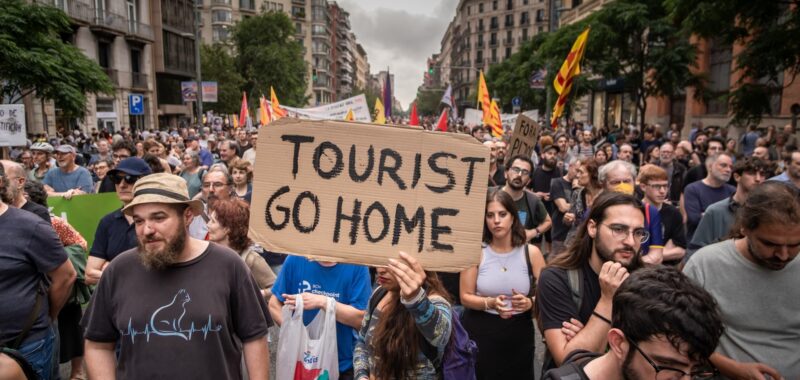On July 6, thousands of anti-tourism protesters marched through the streets of Barcelona, shouting: “Tourists go home!”
A little more than a month later, Spain’s tourism board sent a mass email with a different message: “Spain: the summer you’ll want to repeat every year ⦠We can’t wait to see you!”
Tourists caught in the crossfire of Barcelona’s July protest â some of whom endured water guns and confrontations caught on tape â may not be inclined to return. But data shows others weren’t frightened away.
International arrivals to Spain continued to rise this summer, with some 10.9 million arriving in August â a 7% year-on-year increase, according to Spain’s National Statistics Institute. Â
And the top three most popular destinations were the very spots where protesters staged marches this year. Â
Some 2.4 million international travelers visited the Balearic Islands â home to Mallorca â in August, a 4% jump from the same period in 2023, data showed. Another 2.3 million foreigners went to Catalonia â where Barcelona is located â a 6% increase from 2023. Some 1.6 million went to Andalusia, up 9% year-on-year.
A survey published by Mallorca’s tourism board showed 89% of American travelers said they were either unaware or unconcerned about the protests that occurred on Mallorca this year, according to the travel news website Skift. Â
Of those who knew about the demonstrations, nearly 70% said they had “no impact” on their travel intentions, Skift reported.
‘Bookings bounced back’
Most visitors to Spain are fellow Europeans. However, Booking.com â Europe’s largest online travel agency by market share â told CNBC Travel it didn’t see any meaningful shifts in post-protest bookings to Mallorca or Barcelona.
But RateGain, a software company that processes transactions and intent data for the global travel industry, said it saw a “notable impact” in searches and bookings to Barcelona after the July 6 protest.
The effect, however, was short-lived. “We observed a 23% decline in hotel bookings within 7 to 10 days of the event, along with a 35% drop in search activity,” a company representative told CNBC.
Within six weeks, “bookings bounced back.”
‘Not the end’
Barcelona’s July 6 protest “is not the end of anything,” said Daniel Pardo Rivacoba, a member of the Assembly of Neighbourhoods for Tourism Degrowth, the organization behind the protest.
Rather it was a step toward the organization’s larger goals â a published list of 13 demands â that call on Barcelona’s officials to reverse plans to expand the city’s airport, reduce the number of cruise terminals near the city, curtail the short-term rental market, and end tax-funded tourism promotion of the city. Â
Barcelona’s city council didn’t directly respond to the July 6 protest, Rivacoba told CNBC Travel, but it has since announced new measures aimed at tackling overtourism, including the 135-page “Government Measure For Tourism Management 2024-2027” released on Sept. 17.
The measure outlined 55 actions to help strike a better balance between tourists and residents.
But it’s all just “cosmetic speeches and social washing,” said Rivacoba.
A spokesperson for Barcelona’s City Council told CNBC Travel that managing the city’s tourism is one its main priorities since it is “reaching a limit with 17 million visitors per year.”
“Tourism is strategic for the city economy so it represents 14% GPD,” the spokesperson said. “The measure of success of tourism in Barcelona cannot focus on the volume of visitors but rather on managing the flow of people so as not to exceed a social and environmental limit.”
Managing visitors flows is a strategy that is fast gaining ground as a way to mitigate overtourism, from the use of sensors and mobile phone monitoring tools to provide real-time crowd data.
That’s not good enough for Rivacoba’s organization, which advocates for a reduction in tourist numbers, he said.
In regards to the recent decision by the city council to increase a nightly tourism surcharge by 4 euros ($4.38), Rivacoba said “this will in no way be a measure to decrease tourism, but to collect more money.”
‘Winning the struggle’
Despite claims that an influx of summer tourists humiliated protesters, Rivacoba said they are enthusiastic.
“Public opinion of the people from Barcelona about touristification changed a lot, from the official narration ‘tourism is good for everyone’, which is no longer believable for anyone, to ⦠‘touristification went too far,” he said.
Rivacoba said more than 15,000 people marched on July 6, though local media have reported the number to be around 3,000 people.
He also said media coverage about overtourism has changed. “Not so long ago we were mistreated, or directly ignored,” he said. But during and after the July march, he said the organization has received both sympathy and solidarity from local and international journalists.
“Both things prove we are somehow winning the struggle,” he said.
Who leads?
The Assembly of Neighbourhoods for Tourism Degrowth, on its website, states that residents will be the biggest force for change for Barcelona’s mass tourism problems.
It states that more territories are mobilizing and are “working on joint dates for large mobilizations, meetings of our organizations and shared strategies.”
As to whether more protests are being organized: “Yes, of course,” Rivacoba said.
Booking Holdings’ CEO Glenn Fogel weighed in on the protests, telling CNBC Travel on Sept. 6 that they are “not the most effective way,” to tackle overtourism, and may even “have the wrong effect.”
He said alleviating overtourism “really is a responsibility of governments,” but solving it will require cooperation between governments, travelers, residents and travel companies.
“It’s all the people who get benefit economically from the incoming tourists,” Fogel said.

